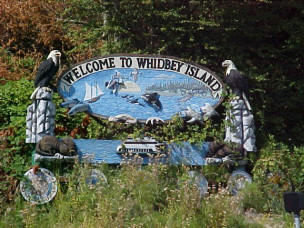|
Whidbey Island (historical spelling Whidby) is one of
nine islands in Island County, Washington. The others are Camano Island
(second largest and to the east of Whidbey), Baby (or Hackney), Ben Ure,
Deception, Kalamut, Minor, Smith, and Strawberry. Whidbey is an island
forming the northern boundary of the Puget Sound in Washington State,
USA. The nine islands comprise all of Island County. Whidbey Island is
home to 58,211 residents (2000 census), also known as 'Whidbey
Islanders'. It is located about 30 miles (50 km) north of Seattle, and
lies between the Olympic Peninsula and the I-5 corridor of western
Washington. The west coast of the island looks toward the eastern
entrance to the Strait of Juan de Fuca and Admiralty Inlet; Puget Sound
is to the south; Possession Sound and Saratoga Passage are on the east;
and Fidalgo Island lies across Deception Pass to the north. It is
between 36 miles (58 km) and 62 miles (100 km) long (from the extreme
north to extreme south, depending on the source of the measurement)
making it the second largest and second or third longest in the
continental U.S., and 1.5 to 12 miles (2 to 18 km) wide. With 168.67 mi²
(436.85 km²) of land area, Whidbey Island is the third largest island in
the contiguous United States after Long Island, NY, and Isle Royale, MI.
The 2000 census reported a population of 58,211 |
|
|
|
History
The island was once inhabited by members of the Skagit, Swinomish,
Suquamish, Snohomish and other Native American tribes. Whidbey Island
was discovered by Europeans in 1790 by Captain George Vancouver. In May
of that year, Joseph Whidbey along with Peter Puget began to map and
explore the areas of Puget Sound. Whidbey circumnavigated Whidbey Island
in June, and Capt. Vancouver named it after him.
The first known overnight stay on Whidbey Island by a non native
American was by Catholic missionary Father Blanchet, while traveling
across Puget Sound, on 26 May 1840.
LT Charles Wilkes, Commander of the triumphant U.S. Exploring Expedition
of 1838-1842 (which proved the existence of the Continent of Antarctica
and brought back 40 tons of specimens from around the world, which
became the basis for the Smithsonian Institution), sailed the USS
Vincennes into Penn Cove in 1841. There he found the largest Indian
settlement of Puget Sound and noted a mission had been started with a 2
acre fenced garden. Wilkes named the lower cove after his assistant
surgeon, Silas Holmes (Holmes Harbor).
In 1850, Colonel Isaac N. Ebey became the first permanent settler on
Whidbey Island, claiming a square mile of prairie with a southern
shoreline on Admiralty Inlet. Even though he was farming potatoes and
wheat on his land, he was also the postmaster for Port Townsend,
Washington and rowed a boat daily across the inlet in order to work at
the Post Office there. On August 11, 1857, Colonel Ebey was murdered and
beheaded at age 39 by Haida Indians who travelled from the Queen
Charlotte Islands (Canada) looking for revenge against the first white
leader they happened upon. Their original intended victim was supposedly
Dr. John Kellogg, who lived near the present day lighthouse at Admiralty
Head. Fort Ebey (established in 1942) on the west side of the central
part of the island (just northwest of Coupeville) is named in Colonel
Ebey's honor as is Ebey's Landing, the beachfront located just below the
still-standing home Ebey lived in with his family.
The Admiralty Head Lighthouse is located in this area on the grounds of
Fort Casey State Park. The area around Coupeville is the federally
protected Ebey's Landing National Historical Reserve in honor of Isaac
Ebey.
|






